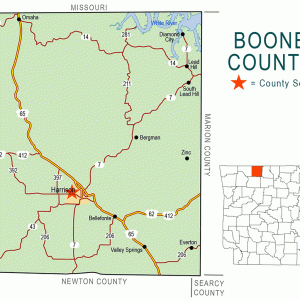calsfoundation@cals.org
Bergman (Boone County)
| Latitude and Longitude: | 36°18’58″N 093°00’28″W |
| Elevation: | 1,211 feet |
| Area: | 1.30 square miles (2020 Census) |
| Population: | 426 (2020 Census) |
| Incorporation Date: | April 3, 1968 |
Historical Population as per the U.S. Census:
|
1810 |
1820 |
1830 |
1840 |
1850 |
1860 |
1870 |
1880 |
1890 |
1900 |
|
– |
– |
– |
– |
– |
– |
– |
– |
– |
– |
|
1910 |
1920 |
1930 |
1940 |
1950 |
1960 |
1970 |
1980 |
1990 |
2000 |
|
– |
– |
– |
– |
– |
– |
249 |
320 |
324 |
407 |
|
2010 |
2020 |
|
|
|
|
|
|
|
|
|
439 |
426 |
|
|
|
|
|
|
|
|
Bergman is a town on State Highway 7 several miles northeast of Harrison (Boone County). Originally a stop on the White River line of the Iron Mountain Railroad, Bergman is best known in the twenty-first century for its role in the poultry industry of Arkansas.
Before Bergman was established, a few homesteaders settled in the forested hills of what would become Boone County. The Fancher expedition, traveling west to Oregon Territory, camped in the area one night, and its campground was thereafter known locally as Oregon Flat. John Snyder was the first resident of the land where Bergman would be built to claim a patent for his land—he did so in 1877—but earlier residents included James Seals, Joseph Abraham York, and James Monroe Davidson. A post office named Oregon existed in Oregon Flat from 1879 until 1896.
The St. Louis, Iron Mountain and Southern Railroad built a rail line from Newport (Jackson County) to Nevada, Missouri, early in the twentieth century. Construction in Boone County took place in 1904 and 1905, with a steam shovel cutting through the higher land and a trestle built to pass over the lower valleys. Even before construction of the railroad began, the Oregon Investment Company had platted a town briefly known as Clabby (reportedly named for a railroad worker) before it adopted the name Bergman. The first postmistress in the town was Edith Bergman, and the post office and town bore her name. A store had been built in the area by 1902, and the store’s owner, W. B. Breece, became postmaster in 1905. The town was incorporated in April 1905, but incorporation was allowed to lapse before the 1910 census was recorded.
A Methodist church was established in Bergman in 1909, and the church building was also used for a public school until a schoolhouse was built in 1918. A canning factory was built in 1912, which remained in business until the Depression twenty years later. Before the town of Bergman celebrated its tenth anniversary, it already had three hotels, seven stores, three restaurants, a jewelry store, a lumber yard and sawmill, two blacksmith shops, a printing shop, and a poultry-processing plant.
William Halbrook became county examiner for Boone County’s schools in 1925, and he spent the next eight years consolidating the county’s many schools into eight school districts. Bergman was one of the eight school districts selected by Halbrook to remain, and a new consolidated school was built in the town in 1929. Ten acres were given to the new campus, and five school buses were purchased to gather students from an area of roughly a hundred square miles. During the 1930s, the Bergman and Lead Hill (Boone County) school districts combined grades seven through twelve.
A fire destroyed several of the older buildings in Bergman in 1944. During the 1940s, a pallet factory opened in Bergman. Passenger train service to the town was discontinued in 1960. Citizens of the town chose to renew their incorporation in 1968, and shortly thereafter, a grant and a loan from the federal government enabled the town government to develop a municipal water system, drilling a well, building a water tank and a pumping system, and laying ten miles of pipeline. In 1983, the town of Bergman had four stores, three churches (Methodist, Church of Christ, and Pentecostal), and the public school.
In 1987, Tyson Foods built a poultry feed mill in Bergman. Among the dignitaries who attended the dedication of the facility were Don Tyson, Senator Dale Bumpers, and Congressman John Paul Hammerschmidt. Located near the railroad, the mill is able to produce 120 tons of feed per hour. More than 100 poultry houses were built in the vicinity in the late 1980s to benefit from the mill’s output.
The feed mill and the school district remain the largest employers in Bergman in the twenty-first century. Nearly 1,100 students were enrolled in the school district in 2014. The high school building, built in 1930, is on the National Register of Historic Places. Bergman has at least five churches, including the Methodist church, two Baptist churches, an Assembly of God, and a nondenominational church calling itself Brand New Church.
For additional information:
Boone County Historical & Railroad Society Inc. History of Boone County, Arkansas. Paducah, KY: Turner Publishing Company, 1998.
Butler, Kent. “Bergman: A Backward Look.” Boone County Historian 18 (April–June 1995): 52–58.
Marler, Gladys, and Bonnie Mears. “A History of Bergman, Arkansas.” Boone County Historian 6 (1983): 256–257.
Steven Teske
Butler Center for Arkansas Studies
 Boone County Map
Boone County Map 




Comments
No comments on this entry yet.